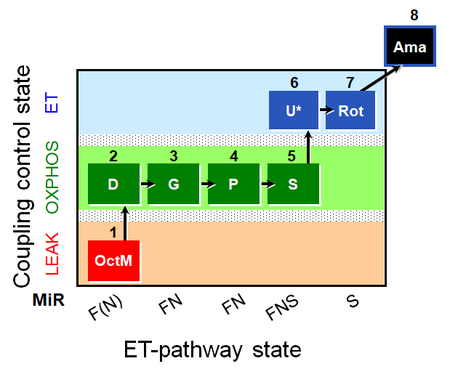Difference between revisions of "Template:SUIT-015 O2 pti D043"
From Bioblast
| Line 25: | Line 25: | ||
*{{Template:SUIT F}} | *{{Template:SUIT F}} | ||
*{{Template:SUIT OXPHOS}} | *{{Template:SUIT OXPHOS}} | ||
|- | |- | ||
| Line 31: | Line 30: | ||
| [[OctGM]]<sub>''[[OXPHOS|P]]''</sub> | | [[OctGM]]<sub>''[[OXPHOS|P]]''</sub> | ||
| [[FN]] | | [[FN]] | ||
| CETF& | | CETF&CI | ||
| 1OctM;2D | | 1OctM;2D;3G | ||
*{{Template:SUIT F}} & {{Template:SUIT N}} | *{{Template:SUIT F}} & {{Template:SUIT N}} | ||
*{{Template:SUIT FN}} | *{{Template:SUIT FN}} | ||
*{{Template:SUIT OXPHOS}} | *{{Template:SUIT OXPHOS}} | ||
| Line 53: | Line 41: | ||
| [[OctPGM]]<sub>''[[OXPHOS|P]]''</sub> | | [[OctPGM]]<sub>''[[OXPHOS|P]]''</sub> | ||
| [[FN]] | | [[FN]] | ||
| CETF& | | CETF&CI | ||
| 1OctM;2D | | 1OctM;2D;3G;4P | ||
*{{Template:SUIT F}} & {{Template:SUIT N}} | *{{Template:SUIT F}} & {{Template:SUIT N}} | ||
| Line 65: | Line 53: | ||
| [[FNS]] | | [[FNS]] | ||
| CETF&CI&II | | CETF&CI&II | ||
| 1OctM;2D | | 1OctM;2D;3G;4P;5S | ||
*{{Template:SUIT F}} & {{Template:SUIT N}} & {{Template:SUIT S}} | *{{Template:SUIT F}} & {{Template:SUIT N}} & {{Template:SUIT S}} | ||
| Line 76: | Line 64: | ||
| [[FNS]] | | [[FNS]] | ||
| CETF&CI&II | | CETF&CI&II | ||
| 1OctM;2D | | 1OctM;2D;3G;4P;5S;6U | ||
*{{Template:SUIT F}} & {{Template:SUIT N}} & {{Template:SUIT S}} | *{{Template:SUIT F}} & {{Template:SUIT N}} & {{Template:SUIT S}} | ||
| Line 88: | Line 76: | ||
| [[S]] | | [[S]] | ||
| CII | | CII | ||
| 1OctM;2D | | 1OctM;2D;3G;4P;5S;6U;7Rot | ||
*{{Template:SUIT Rot}} | *{{Template:SUIT Rot}} | ||
| Line 98: | Line 86: | ||
| | | | ||
| | | | ||
| 1OctM;2D | | 1OctM;2D;3G;4P;5S;6U;7Rot | ||
*{{Template:SUIT Ama}} | *{{Template:SUIT Ama}} | ||
Revision as of 12:43, 14 February 2019
Steps and respiratory states
| Step | State | Pathway | Q-junction | Comment - Events (E) and Marks (M) |
|---|---|---|---|---|
| 1OctM | OctML | F(N) | CETF | 1OctM
|
| 2D | OctMP | F(N) | CETF | 1OctM;2D
|
| 3G | OctGMP | FN | CETF&CI | 1OctM;2D;3G
|
| 4P | OctPGMP | FN | CETF&CI | 1OctM;2D;3G;4P
|
| 5S | OctPGMSP | FNS | CETF&CI&II | 1OctM;2D;3G;4P;5S
|
| 6U | OctPGMSE | FNS | CETF&CI&II | 1OctM;2D;3G;4P;5S;6U
|
| 7Rot | SE | S | CII | 1OctM;2D;3G;4P;5S;6U;7Rot
|
| 8Ama | ROX | 1OctM;2D;3G;4P;5S;6U;7Rot
|
| Step | Respiratory state | Pathway control | ET-Complex | Comment |
|---|---|---|---|---|
| ## AsTm | AsTmE | CIV | CIV | |
| ## Azd | CHB |
- Bioblast links: SUIT protocols - >>>>>>> - Click on [Expand] or [Collapse] - >>>>>>>
- Coupling control
- Pathway control
- Main fuel substrates
- » Glutamate, G
- » Glycerophosphate, Gp
- » Malate, M
- » Octanoylcarnitine, Oct
- » Pyruvate, P
- » Succinate, S
- Main fuel substrates
- Glossary

